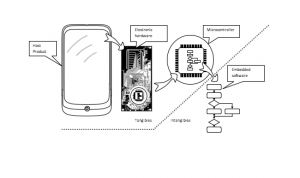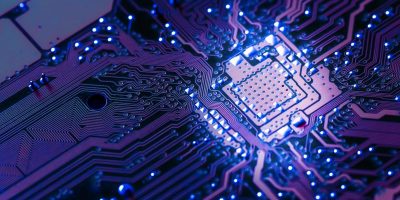A guide to developing electronic based systems – Part 1
Part 1 – Electronic system overview
The purpose of this series of articles is to describe in clear terms what is involved in the development of systems which include custom made electronics. The tasks involved include specifying, designing and developing electronic hardware and software that will provide a set of required functions and facilities for an electronic product. Together these tasks are often described as embedded engineering. Each of the papers will include a set of definitions which it is hoped will be helpful to the reader and set the scene for the papers. We include below therefore definitions of four terms which relate to embedded engineering
Embedded system: A system comprising of one or more components, designed to provide autonomous functions. These systems can be embedded within a product. A car braking system is an example.
Embedded software: The intangible components of a computer embedded within an electronic product or system.
Microcomputer: A small computer embedded within an electronic device which can be programmed with embedded software to perform specific autonomous functions.
Microcontrollers: A specialist type of microcomputer which includes the capability to process signals as well as data. The signals are processed by silicon blocks within the micro-controller. Blocks that convert analogue signals to digital data (A-D convertors) are an example.
Throughout the series, reference will be made to Synergy. Synergy is the name of a family of microcontrollers available from Renesas. Each family member is targeted at particular areas of the market place. The S1 for example is designed for use in markets where low power is essential, whereas the S7 could be used for video processing. The Synergy offering also includes targeted embedded software.
When starting the design of an electronic system, the purpose and scope of the application should be studied in order to inform which components and in particular which microcontroller should be selected.

Figure 1
A stylised illustration of a host electronic product is shown in figure 1, decomposed into key components and sub-components. Selection of components is a significant part of the work of the designer but it is important not to make the process too complicated. The starting point as stated in KP1 is consideration of the function of the product. From this appropriate technology options can be assessed and from this the components selected. If, for example, the host product is to include video streaming, technologies to support fast processing will be required. But if instead the product is to be used for data collection, robust and secure communications may be more important. In addition, when data is to be collected from, say, a health monitor, the ability to capture data from a sensor will be needed. Each product therefore will be different in detail and as a result be subject to specific design; but, in simple terms, each design will need to consider communications functions, processing functions and sensing functions. Final selection of components is not likely to occur until later in the development; issues such as cost and longevity will come into play. Timing of component selection will be dependent on the design and development strategy chosen and particular attention has to be given to the intangible embedded software component, which most often will require development alongside that of the tangible product. The Synergy range however has been designed to cater for a broad range of application areas. Significant support for software development is also included, making it easy to integrate into a company’s design and development strategy.
Selecting the most appropriate strategy is no simple task and will depend on the level of ambiguity and uncertainty involved. Simple questions such as, how much research and trialling will be needed in order to de-risk the project should be asked in order to set the correct path forward. Methods and processes to support product development strategies are plentiful but they can be split generically into staged approaches, where one set of tasks needs to be completed before the next begins. Agile approaches, with time at the core, are often chosen. All strategies however have one aim in common; to finish on time and within budget.
Maybe the most important question to ask when starting out on a project is ‘What is meant by finish?’ Is it when a working model is demonstrated, or do we mean when a set of acceptance tests have been passed. All too often I have reviewed plans where there is no firm definition of finish, or where tests and criteria that firm up the finish line have not been thought about. The situation is further exacerbated when unstated assumptions are relied upon to achieve success.
One way of avoiding common pitfalls is to consider the life-cycle of the product or system being developed. Working backwards from deployment in the market place through to launch and then to the development can stop simple errors such as leaving out maintenance functions from the software development or omitting design for manufacture. Extra care taken during the design process to ensure that the product can be well-serviced and maintained throughout its lifecycle will pay dividends. This is particularly important in fast moving markets where product families or customised products are required. Re-usable components and technology platforms to support such market places can be designed in from day one and it is particularly in this arena that Synergy can play an integral part.
The target market and the life-cycle go hand-in-hand, but it should be remembered a product may have multiple life-cycles depending on which markets are being addressed. Furthermore, different markets may have different requirements for conformance and end-of-life handling. The myriad of different standards that must be adhered to can appear daunting but if good processes are adopted and information, particularly records of tests undertaken and decisions made, is collected in a technical file, most requirements can be easily met. All electronic products will need to undergo Electromagnetic Compatibility (EMC) testing before they can be placed onto the market. Mains powered devices will also be subject to the requirements of the Low Voltage Directive (LVD) and those containing any wireless communication the Radio Equipment Directive (RED). The requirements for these standards along with any specific market standards, such as those for Medical and Automotive products need to feature in the overall product requirement.
Developing an electronic product is multi-faceted, and each facet requires significant skill to complete. The key is to ensure that all the work is undertaken diligently and visibly so that the design can be easily proven.
Article series by: Dr. Val Lynch, CEO von AND Technology Research
Steve Norman, Manager Global Ecosystems, Renesas Electronics Europe
Find out more about the Renesas Synergy platform supports embedded system development: https://www.renesas.com/en-eu/products/synergy/features.html




